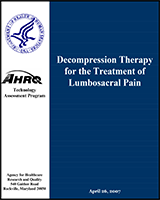This publication is provided for historical reference only and the information may be out of date.
Decompression Therapy for the Treatment of Lumbosacral Pain
Technology Assessment Report
Authors
Marie Jurecki-Tiller, PhD, Wendy Bruening, PhD, Stephen Tregear, DPhil, Karen Schoelles, MD, SM, Eileen Erinoff, BA, and Vivian Coates, MBA.Affiliations
The Centers for Medicare and Medicaid Services (CMS) requested that AHRQ commission an evidence report to assist in updating the CMS policy regarding decompression therapy for chronic low back pain. Accordingly, on January 17, 2006, AHRQ issued a Statement of Work (SOW) contracting ECRI to prepare an evidence report titled, “Decompression Therapy for the Treatment of Lumbosacral Pain.” The SOW specified that ECRI undertake the following tasks:
- Systematically search, review, and analyze the relevant scientific evidence appropriate for each question. Search Medline and other suitable databases containing primary literature relevant to the questions to be addressed. Identify other sources of relevant literature, such as gray literature, clinical trials currently in progress, and clinical practice guidelines.
- Retrieve and review full articles on eligible studies, assessing quality and extracting key data from each eligible study.
- Prepare evidence tables and a summary of important findings.
This report is based on research conducted by the ECRI Institute Evidence-based Practice Center (EPC) under contract to the Agency for Healthcare Research and Quality (AHRQ), Rockville, MD (Contract No. 290-02-0019). The findings and conclusions in this document are those of the author(s) who are responsible for its contents; the findings and conclusions do not necessarily represent the views of AHRQ. Therefore, no statement in this report should be construed as an official position of the Agency for Healthcare Research and Quality or of the U.S. Department of Health and Human Services.
The information in this report is intended to help health care decision-makers; patients and clinicians, health system leaders, and policymakers, make well-informed decisions and thereby improve the quality of health care services. This report is not intended to be a substitute for the application of clinical judgment. Decisions concerning the provision of clinical care should consider this report in the same way as any medical reference and in conjunction with all other pertinent information, i.e., in the context of available resources and circumstances presented by individual patients.
This report may be used, in whole or in part, as the basis for development of clinical practice guidelines and other quality enhancement tools, or as a basis for reimbursement and coverage policies. AHRQ or U.S. Department of Health and Human Services endorsement of such derivative products may not be stated or implied.
